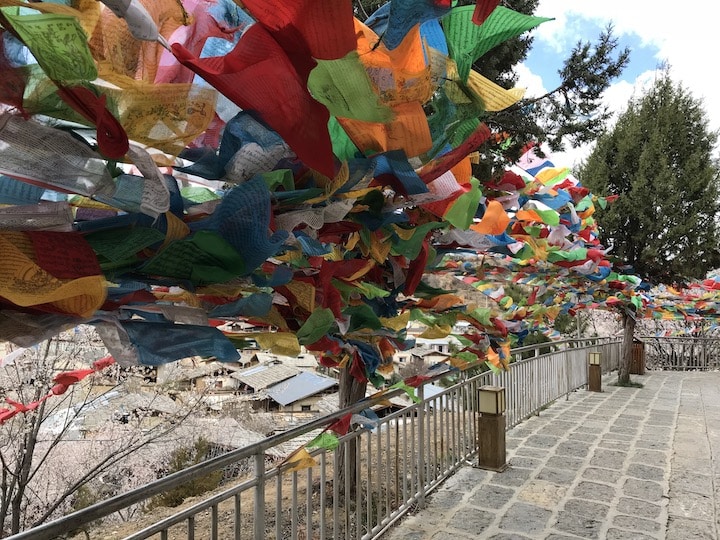
Tibetan prayer flags flying in wind in Shangri-La.
By Scott Busby
It was a crisp Spring day when my wife and I embarked on a remarkable journey in China’s Yunnan Province that would trace part of the Ancient Tea Horse Road – a 1,000-year old network of caravan trails and paths that zigzag through the mountains of Sichuan, Yunnan and Tibet in Southwest China. My wife was born in Kunming, the capital of Yunnan, and proved to be the ultimate tour guide.
The ancient trade route, active from the 6th Century to the 20th Century, was a perilous journey over some of the highest mountain ranges in the world. Despite the dangers, Chinese made the trek to exchange tea for horses with the Tibetans. Today, travelers can trace this historic journey by taking China National Highway G214, which runs for 2,023 miles through Yunnan and deep into Tibet, the beautiful yet beleaguered autonomous region of China.
Our goal was to explore the fabled town of Shangri-La and to get a close-up look at the treacherous Meile Snow Mountain Range, whose highest peaks never have been conquered by climbers. It is a region so remote and isolated that it inspired James Hilton to set his 1933 best-selling novel Lost Horizon in the mythical city of Shangri-La, a lost paradise in these timeless, impenetrable mountains.
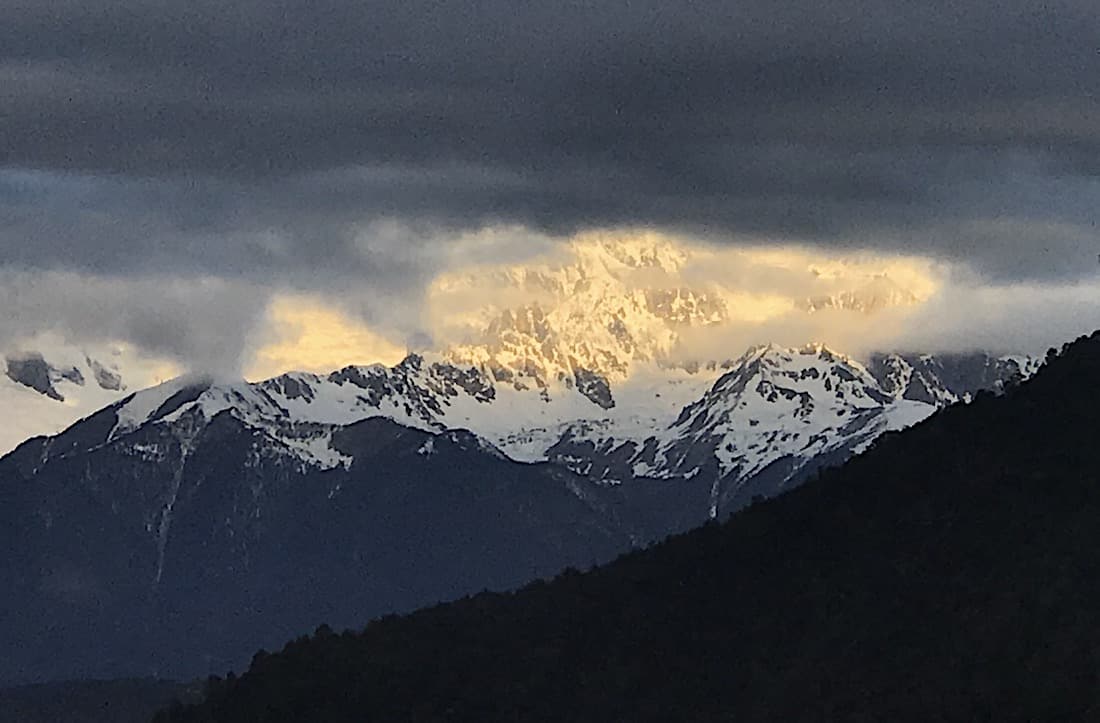
The largely unexplored and unconquered Meile Snow Mountains in China’s Yunnan Province
Our trip would not lead us into Tibet itself, but it would take us within 100 miles of the border and through several of Yunnan’s 16 prefectures and cities, where many of China’s largely Buddhist ethnic groups have lived for centuries and enjoy some degree of autonomy. In Diqing Tibetan Autonomous Prefecture, where Shangri-La is located in Yunnan’s northwestern corner, most people speak the Tibetan language. China has 56 distinct ethnic groups – including a variety of Buddhists (not just Tibetan) – and 29 of those ethnic groups reside in Yunnan, making it the most culturally diverse province in China.
The road to Shangri-La begins in the 800-year-old town of Lijiang – a major trading center on the Ancient Tea Horse Trail – and a 45-minute flight from Kunming. A peaceful river runs through the heart of Old Town Lijiang, where the cobblestone streets are packed with stores, food stands and itinerant merchants. Because of its antiquity and beauty, Lijiang is a favorite destination for pre-wedding photos. At every turn, there are stylish young couples in formal dress posing and smiling.
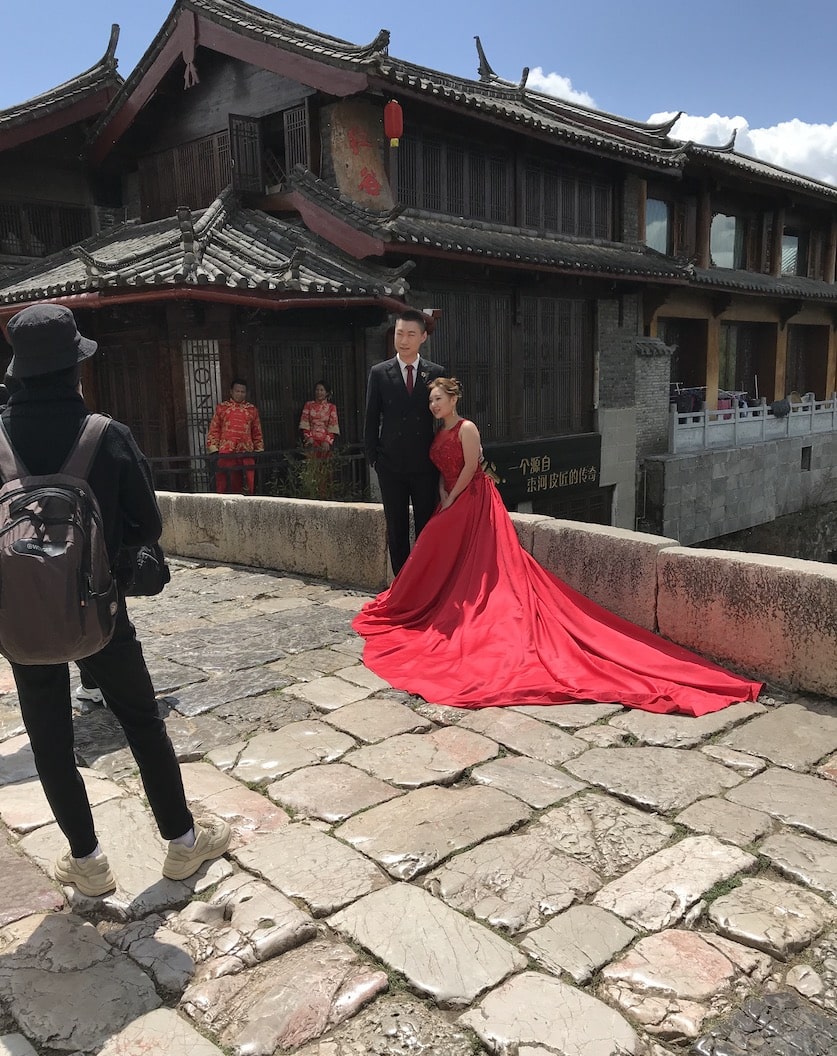
Lijiang is a favorite destination for pre-wedding photos, which are typically shown for the first time at the couple’s reception.
At night, young people flood the city to dine and listen to live music in dozens of bars, restaurants and clubs. We listened to two young men from Mongolia play guitars and sing mostly American rock and R&B classics. After their set, we invited them to our table for drinks. They told us that they had come to Lijiang to “be discovered,” since China’s music industry scouts frequent the Lijiang night scene in search of new talent.
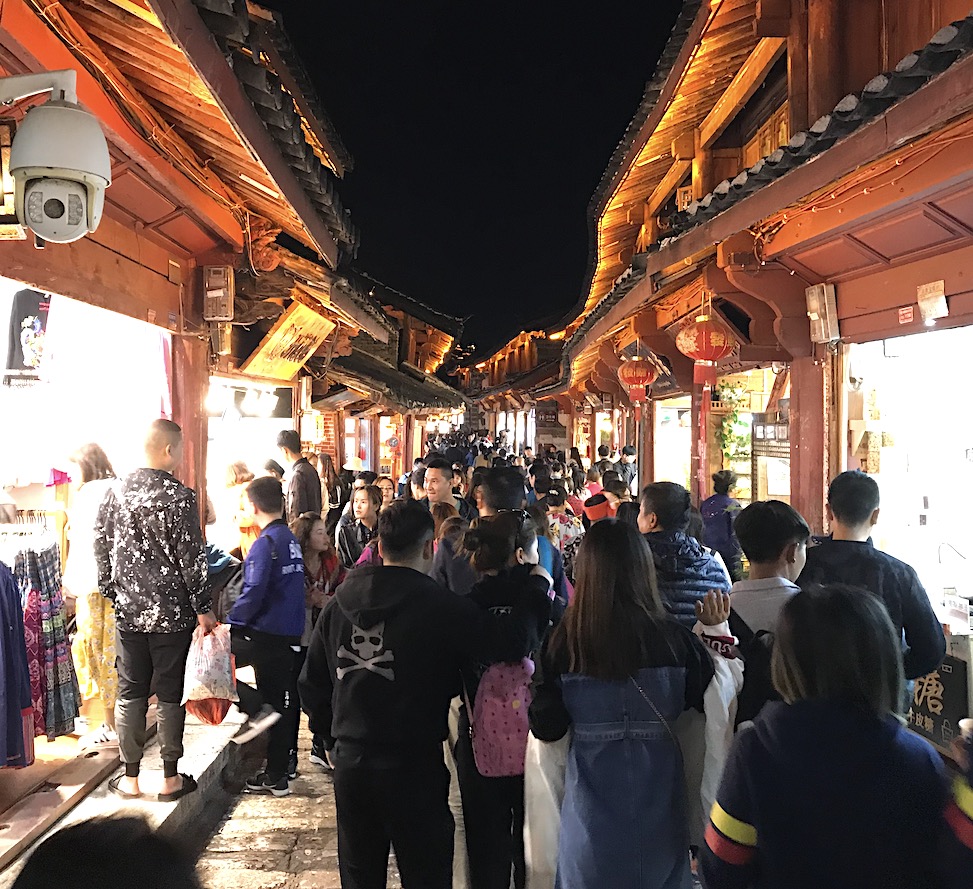
Nightlife on the cobblestone streets of Lijiang
The next day, we hired a car and driver (a common practice in China – even for Chinese travelers – because locals know the roads and best restaurants and stops) and set out toward the high mountains.
One attraction worth visiting is “Lijiang Impressions,” a live musical extravaganza that features hundreds of local citizens performing in an enormous outdoor amphitheater framed by the awe-inspiring Jade Dragon Snow Mountain. It tells the history of the local tribal people through singing, dancing, comedy, marching and drumming – and is among the top five tourist attractions in China. The spectacular show was created by Zhang Yimou, one of China’s most famous filmmakers, who also directed the 1,000-drummers Opening Ceremony at the 2008 Beijing Olympics.
Ascending higher into Yunnan’s rugged mountains, you’ll soon arrive at Leaping Tiger Gorge, China’s smaller-yet-dramatic equivalent to the Grand Canyon. The Jinsha River thunders through this narrow, rocky passage, which honors the legend of a great tiger who escaped hunters by jumping across the river at its narrowest point.
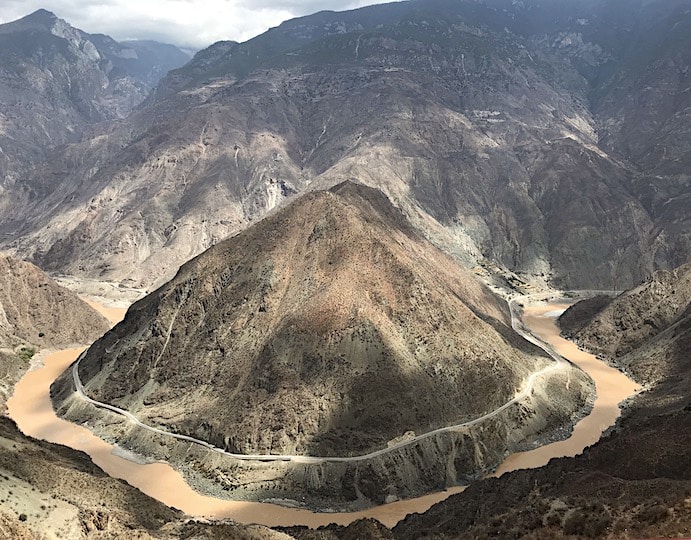
The famous horseshoe bend of the Jinshajiang River, headwaters of the Yangtze River
Climbing ever higher the highway eventually arrives at the horseshoe bend of the Jinshajiang River, which is headwaters of the Yangtze River. It is from this point that the Yangtze flows 3,900 miles in a generally easterly direction to the East China Sea. It is the longest river in Asia, the third-longest in the world, and the longest in the world to flow entirely within one country.
On the outskirts of Shangri-La we booked a room in what turned out to be the flagship hotel of a chain of charming, Tibetan-style country lodges called Songtsam. The brand offers 11 boutique properties – lodges and hotels – many of which are situated along Highway G214 all the way into Tibet. Some of the lodges are literally in the middle of nowhere, designed to make the views and tranquility of the region’s most spectacular mountains their main and only attraction.
This particular Songtsam Lodge is almost next-door to the Gander Sumteseling Monastery and the pristine lake it overlooks. Built in 1679, this Tibetan Buddhist holy site once housed as many as 2,000 monks. It was extensively damaged during the Cultural Revolution and subsequently rebuilt in 1983.
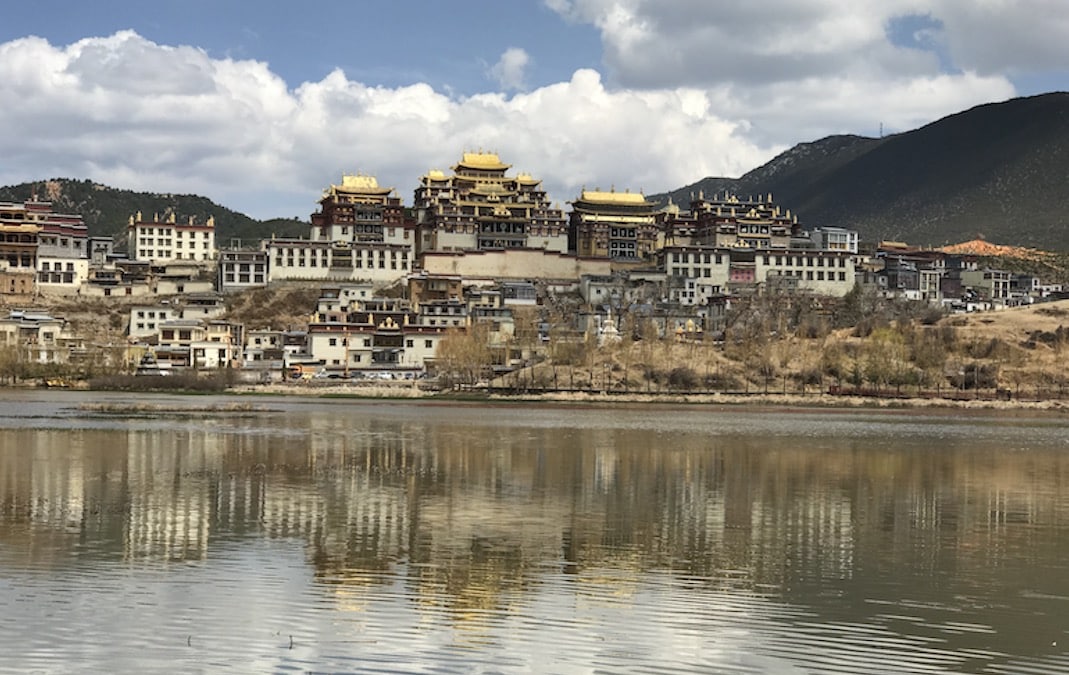
The four-centuries-old Tibetan Buddhist Ganden Sumteseling Monastery was extensively damaged during the Cultural Revolution and subsequently rebuilt.
China has the largest population of Buddhists in the world, approximately 244 million or 18.2% of its total population. They are mostly Mahayana Buddhists. Followers of the other two branches of Buddhism, Theravada and Vajrayana, largely are located in Southeast Asia and Tibet and Mongolia.
The main factors that differentiate between Chinese and Tibetan (Vajrayana) Buddhism involve the different approaches to enlightenment. Chinese Buddhism attracts many followers because it includes aspects of Chinese culture and history, such as Taoism. Tibetan Buddhism features different methods of worship and different deities.
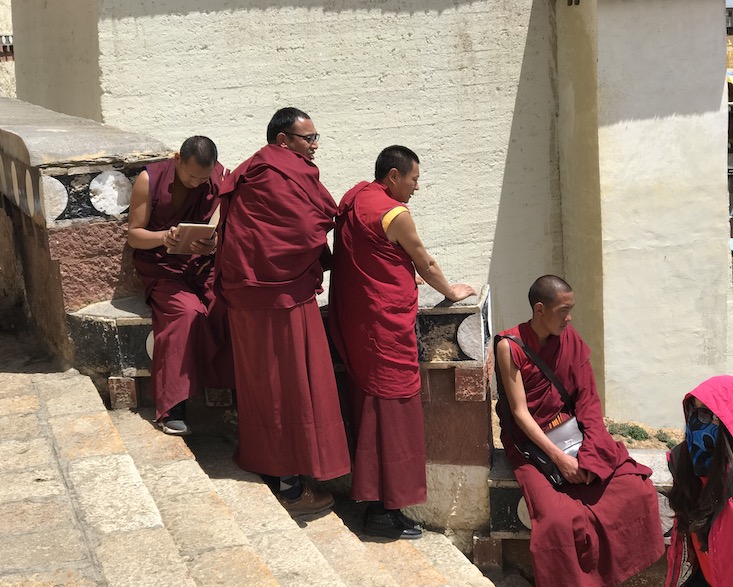
Tibetan Monks hang out on stairs of the Ganden Monastery. At its height, the monastery was home to more than 2,000 monks.
When you enter the picturesque city of Shangri-La, you’re immediately confronted by the confluence of two ancient cultures – Tibetan and Chinese. This blending is evident everywhere in the architecture, language, food, clothing and faces of the people. Originally known only as Zongdian County, the city was renamed Shangri-La 20 years ago in an effort to promote tourism in the region.
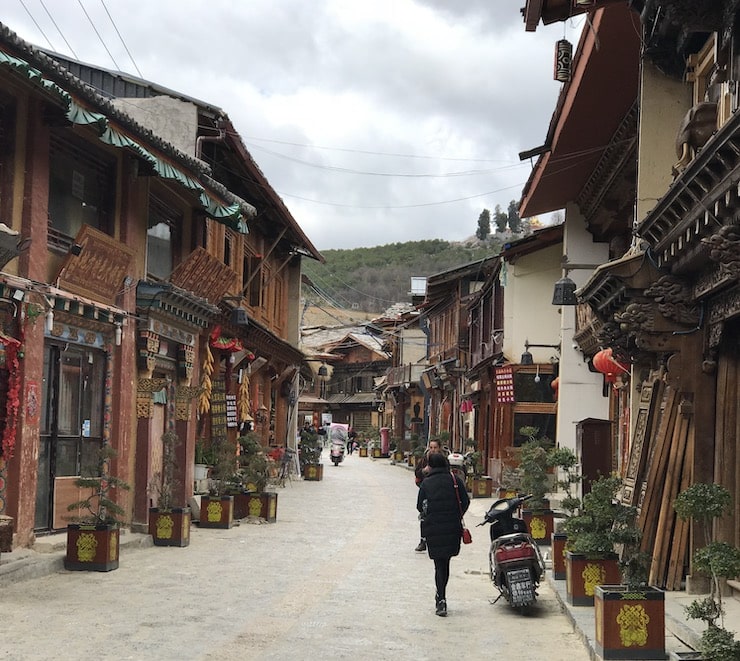
The picturesque town of Shangri-La offers a unique mixture of Chinese and Tibetan cultures.
It is easy to see how James Hilton’s imagination could have run wild when he first visited the verdant, high-mountain valley that surrounds current-day Shangri-La. He even captured the smiling, gentle, Buddhist nature of its people when offering his first impressions of the remote area in his novel. “For the valley was nothing less than an enclosed paradise of amazing fertility, in which the vertical difference of a few thousand feet spanned the whole gulf between temperate and tropical,” he writes in Lost Horizon. “The valley of the Blue Moon that Shangri-La lamasery overlooks is sheltered in the mountains and is both a physical and spiritual paradise. The people are happy and without want.”
The remoteness of the region did not prevent the intrusion of World War II. In 1941-1942, the First American Volunteer Group (AVG) of the China Air Force – famously nicknamed The Flying Tigers – arrived in Kunming to help the Chinese government fight invading Japanese forces. They were commanded by Claire Chennault, a retired Army Air Corps officer, who had worked in China since August 1937 as military aviation advisor to Republic of China President Chiang Kai-shek.
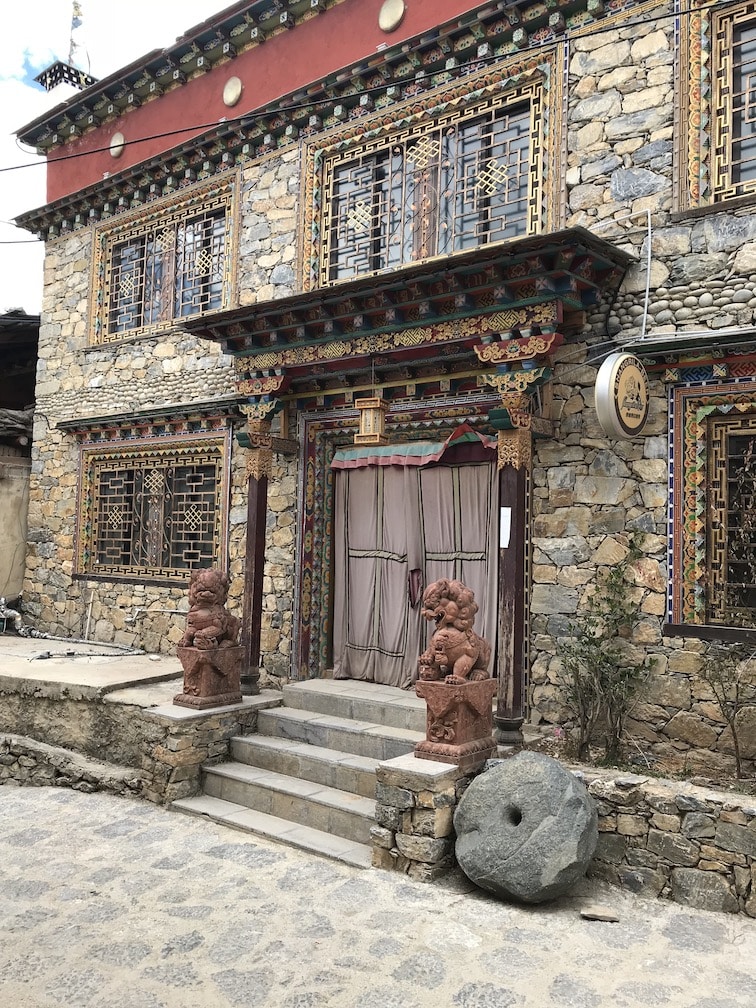
Because of the influx of foreign visitors, a traditional Tibetan home in Shangri-La now serves as a pub.
The Flying Tigers earned numerous combat medals for destroying 296 enemy aircraft, while losing only 14 pilots in combat. Several regional museums honor the Flying Tigers, who are considered national heroes by the Chinese.
Another group of courageous airmen came from the American Tenth Air Force, which flew military transports “Over the Hump” to support the allied war effort in China. Many American flight crews crashed into the rugged terrain. They survived largely because of the bravery of Chinese villagers and Christian missionaries, who rescued and smuggled them to safety.
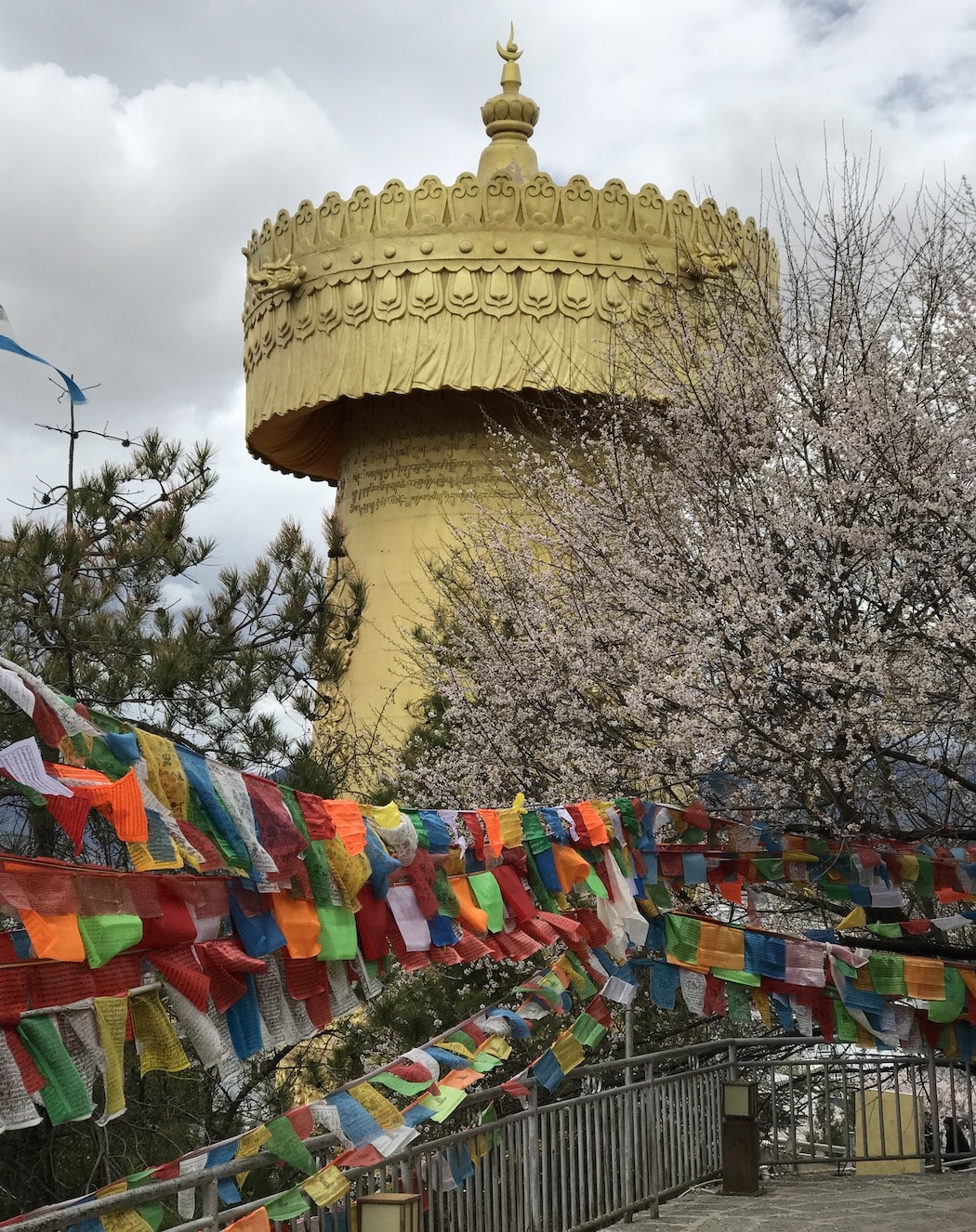
Shangri-La’s Tibetan Pray Wheel is the second largest in the world and a major pilgrimage attraction for Tibetan Buddhists.
The most striking physical feature of Shangri-La is the 68-foot-tall, gold-plated, Tibetan Prayer Wheel. It is second largest in the world and a major pilgrimage attraction for Tibetan Buddhists. In Tibetan culture, the colorful flags that surround the prayer wheel represent prayers that the wind sends to Buddha.
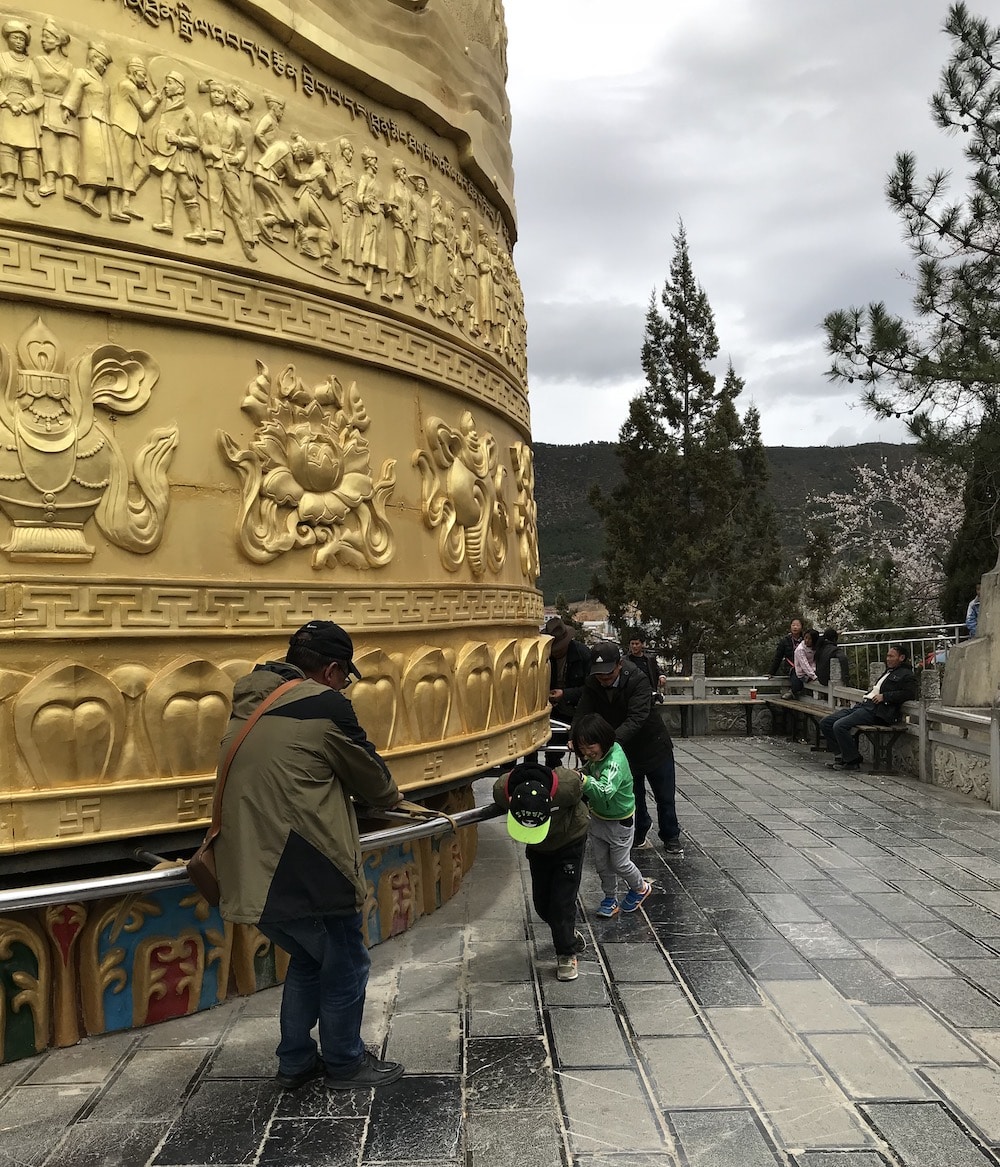
Tipping the scales at more than 60,000 pounds, the rotating Prayer Wheel takes a lot of adult and kid power to get it turning.
We left Shangri-La and continued our ascent toward the Meile Snow Mountains. At 11,397 feet, we paused at an old Tibetan-style road sign – a large stone cross with arms pointing in different directions and marveled at a solo bicyclist taking a well-deserved break from cycling in the thin air.
At these lofty elevations, Highway G214 becomes more narrow, windy and absolutely breathtaking. The road snakes past isolated villages with ancient rice terraces and incongruously modern arrays of solar panels. We completely lost our way one day in thick misty clouds that obscured the road, and once had to brake sharply to avoid a herd of wandering yaks. Local farmers allow their herds of yaks and goats to roam free in the wild mountain landscapes to forage for food before the onset of winter.
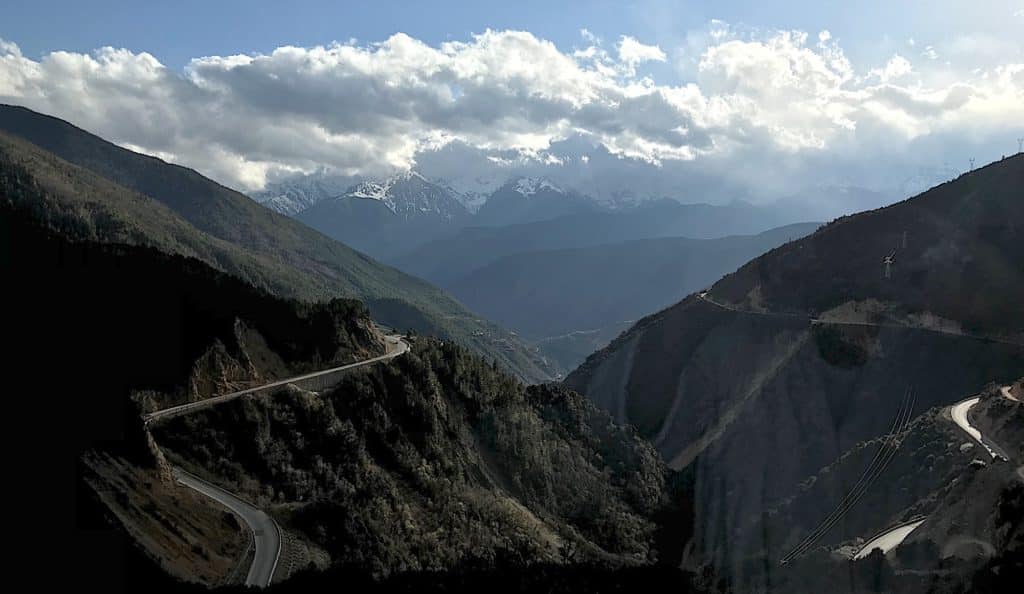
Approaching the Tibetan border, Highway G214 becomes more narrow, windy and absolutely breathtaking.
Near the tiny village of Degen we arrived at our second Songtsam Lodge, which is known for its extraordinary views of the Meile Snow Mountains. The staff welcomed us with a simple, delicious Tibetan dinner of braised yak meat, local vegetables, pan-fried buckwheat bread and a not-so-bad local wine. They also were conscientious about altitude sickness and provided oxygen bottles and medications if necessary. At almost 12,000 feet, it’s wise to keep an oxygen bottle handy at all times.
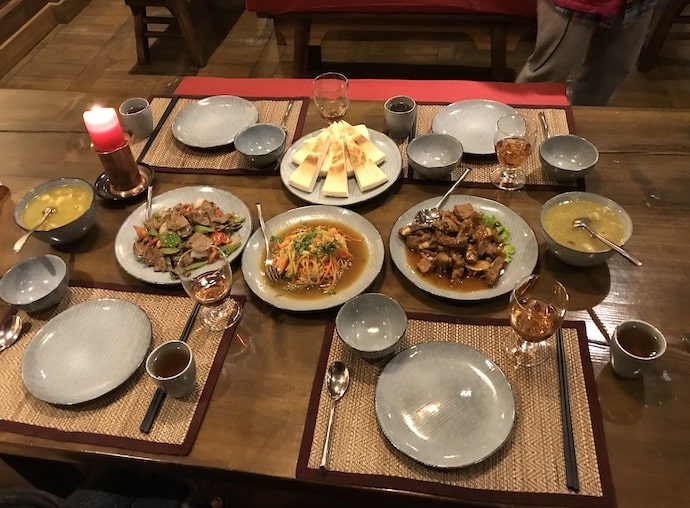
The Songtsam Lodge near the Meile Snow Mountains serves braised Yak meat, local vegetables and pan-fried buckwheat bread in an elegant surrounding.
The attentiveness and service provided by the staffs and managers at all of the hotels where we stayed on our journey was superb. And almost everywhere, a concerted effort was made to keep Chinese cuisine and local ethnic foods palatable to foreigners without losing its authenticity. Overall, the Chinese have largely succeeded in making road trips like ours comfortable for Western travelers. But the Songtsam experience was special and most memorable for me, not only for the once-in-a-lifetime scenery, but also because of how these lodges blended Chinese and Tibetan cultures, customs and foods.
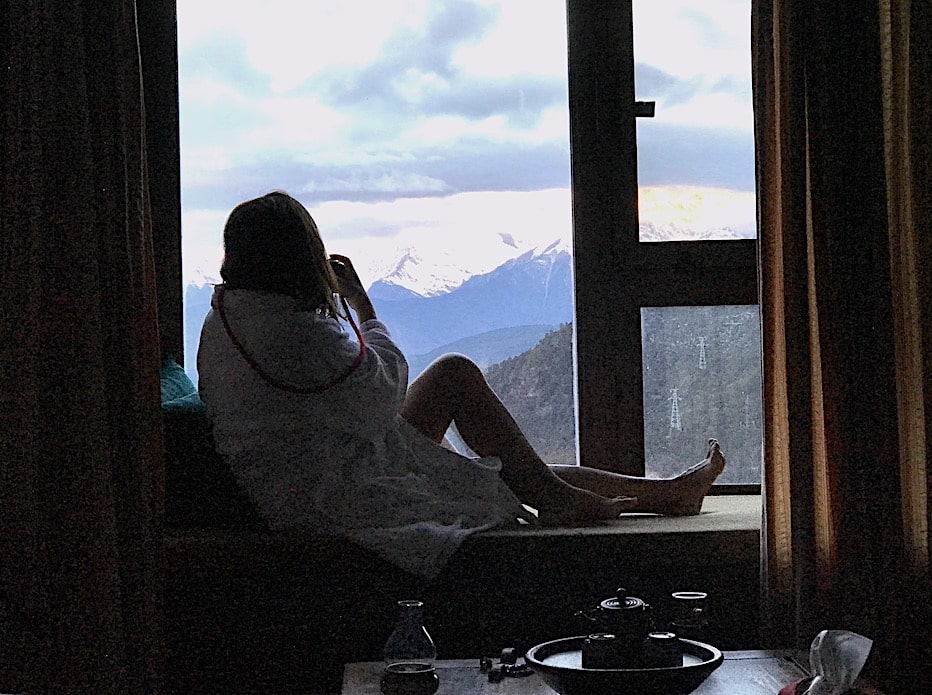
Not many guests spend time checking their e-mail at the Songtsam Hotel when they can spend time looking at the mountains, reading, sipping tea and taking high-altitude naps.
Their breakfast buffets, for example, offered food and drink from all three cultures. And every afternoon, when tea was served in the rooftop library/viewing room, they included a unique, traditional Tibetan tea with Yak butter, Chinese Pu’er Tea – considered one of the finest teas in Asia and the driving force behind the Ancient Tea Horse Road – as well as an array of English and Indian brands.
There is little to do outside the hotel. So guests spend hours meditating on the magnificent views of the Meile Snow Mountains, reading, sipping tea, and taking long high-altitude naps.
Often obscured in clouds, the Meile Snow Mountains are mysterious, virtually inaccessible and extremely dangerous for climbers. None of the major peaks in the range has ever been summited. In January 1991, six Chinese and 11 Japanese mountaineers lost their lives to an avalanche, one of the worst climbing accidents in Chinese history.
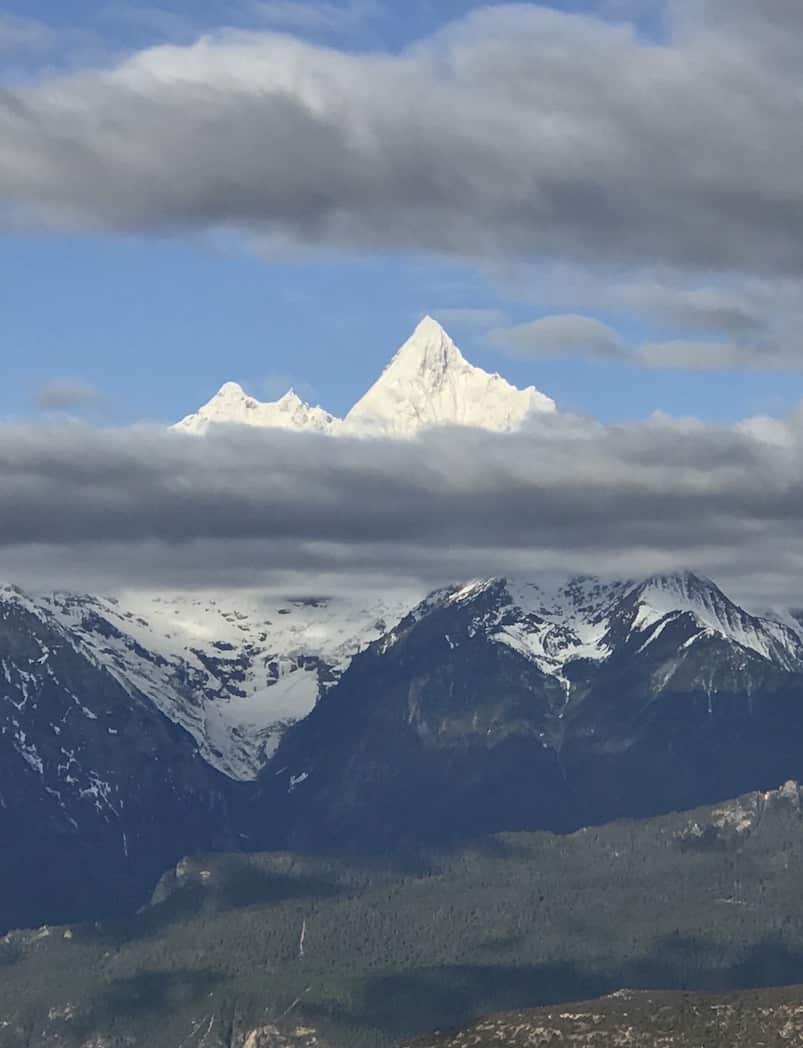
The highest peak in the Meile Snow Mountains is Kawagebo, which rises to 22,110 feet and is considered sacred for Tibetan Buddhists.
Foreign travelers who want to explore this part of China can find organized group tours that operate between Lijiang and Shangri-La, or they can hire a car and driver or rent a car themselves and make the trek up Highway G214. Most major road signs are in Mandarin and English. Cell phone/GPS service is spotty or non-existent in the mountains and gorges, but available in towns and cities along the way.
There are hundreds of multilingual travel agencies all over China able to make travel arrangements. Concierges at major hotels in Kunming and Lijiang are especially good resources for tourism literature, trip planning and car/driver hiring. Many of the drivers are younger and speak at least some English.
Before Covid-19 changed the world, there were 61 non-stop airline routes between the U.S. and mainland China. U.S. carriers United, America, Delta, Hawaii provide service along with six Chinese carriers: Air China, China Eastern, China Southern, Hainan, Xiamen and Sichuan Airlines. Los Angeles, New York, San Francisco, Vancouver and Toronto are the most common departure points in North America for flights to China. A travel visa is required. ![]()
Scott Busby is a journalist, screenwriter, and founder- president of The Busby Group, a strategic communications agency in Los Angeles. His articles have appeared in major newspapers and magazines. Busby has four produced films to his credit and has been involved with film and television productions all over the world for such companies as Miramax, MGM/UA and Columbia Pictures.

